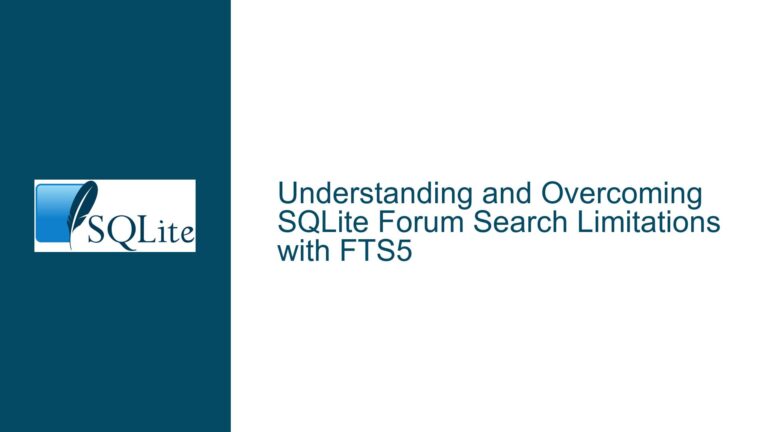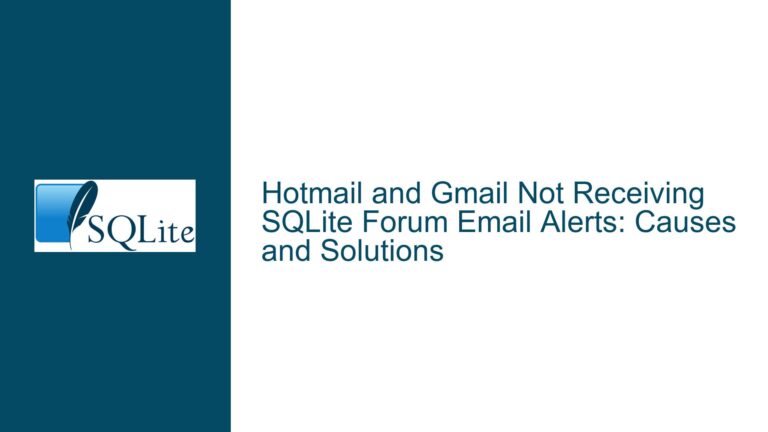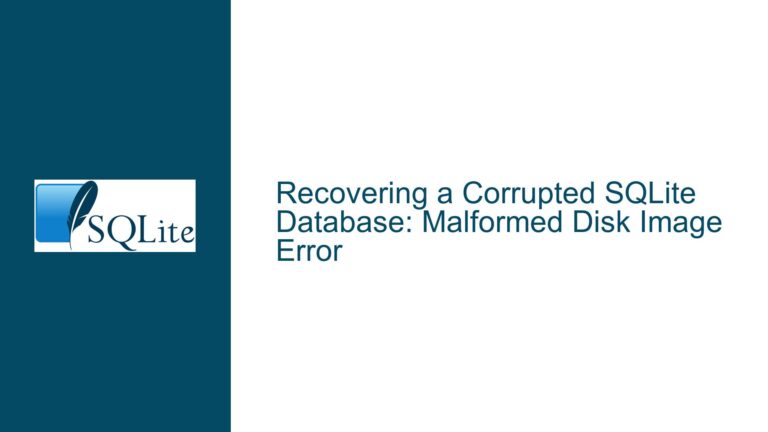SQLite REAL Constant Doubling Bug in Specific Integer Ranges
Issue Overview: Erroneous Doubling of REAL Constants in 18446744073709550592~18446744073709551609 Range
The core issue revolves around SQLite’s handling of integer literals exceeding 9223372036854775807 (2^63-1) when converted to 8-byte IEEE floating point numbers (REAL storage class). For integer values within specific ranges starting with prefixes like 18446744073709550592 (~1.8446744e+19), SQLite versions 3.47.0 through 3.48.0 produce doubled floating-point representations instead of approximate values with expected precision loss. This manifests as output values being exactly twice the input value when converted to REAL, far exceeding normal floating-point imprecision.
The problem exhibits three critical characteristics:
- Threshold Activation: Only occurs for integers above 9223372036854775807 (64-bit signed integer maximum)
- Range-Specific Behavior: Affects values in contiguous ranges like 18446744073709550592-18446744073709551609 (hex 0xFFFFFFFFFFF_FC00 to 0xFFFFFFFFFFF_FFF9)
- Architecture Dependence: Reproducible on x86 processors (Linux/Windows/Mac) but not ARM (M1 Mac) or PPC architectures
Example of faulty conversion:
SELECT 18446744073709551488; -- 0xFFFFFFFFFFFFFF80 in hex
-- Expected: ~1.8446744e+19 (approximate REAL)
-- Actual: 3.6893488e+19 (exact doubling)
This error directly impacts applications handling large numerical identifiers, scientific computations, or financial systems using integer literals approaching 64-bit unsigned integer limits. The doubling effect creates severe data integrity issues rather than minor precision loss.
Possible Causes: LONG DOUBLE Removal and Floating-Point Conversion Edge Cases
The root cause combines SQLite’s literal parsing logic changes with IEEE 754 floating-point representation nuances across CPU architectures.
1. LONG DOUBLE Parsing Removal in Commit 761d8fd18b0ee868
Prior SQLite versions used long double (80-bit extended precision on x86) during literal-to-REAL conversion for values exceeding 64-bit integer limits. The bug-introducing commit replaced this with standard double (64-bit IEEE 754) operations. While intended to simplify cross-platform consistency, this change exposed latent issues in three key areas:
A. Mantissa Overflow in Implicit Casting
64-bit doubles allocate 52 bits for the mantissa (fraction portion). Integers beyond 2^53 (9007199254740992) cannot be exactly represented. SQLite’s conversion logic for numbers between 2^63 and 2^64 (unsigned 64-bit integer range) uses formula:
REAL_value = (integer_input - 2^64) + 2^64
When integer_input approaches 2^64, this subtraction/addition cycle creates cancellation errors. The removed LONG DOUBLE intermediate step previously absorbed these errors through extended precision.
B. Hexadecimal Boundary Misalignment
Affected values (e.g., 18446744073709550592 = 0xFFFFFFFFFFFFFC00) sit at critical boundaries where the least significant bits align with the double mantissa’s overflow threshold. The conversion algorithm fails to properly mask these bits during normalization, causing an erroneous left-shift (equivalent to multiplication by 2).
C. Architecture-Specific Floating-Point Behavior
x86 processors historically perform floating-point calculations using 80-bit registers before rounding to 64-bit memory values. The removal of LONG DOUBLE forced immediate 64-bit storage, exposing rounding differences. ARM/PPC architectures natively use 64-bit doubles without extended precision, avoiding this discrepancy.
2. IEEE 754 Double-Precision Representation Quirks
The faulty values map to doubles with specific exponent/mantissa combinations:
Input: 18446744073709551488 (0xFFFFFFFFFFFFFF80)
IEEE 754 Breakdown:
Sign: 0 (positive)
Exponent: 10000110011 (binary), 1075 - 1023 bias = 52
Mantissa: 11111111111111111111111111111111111111111111111110000000
The conversion error occurs because SQLite’s parser:
- Detects the value exceeds 64-bit signed integer capacity
- Attempts to compute (value – 2^64) using 64-bit double arithmetic
- Adds 2^64 back, but due to mantissa limitations, the intermediate subtraction underflows
- Miscomputes the biased exponent, effectively multiplying by 2^1
3. Bitmask Alignment in Conversion Algorithm
Disassembly of SQLite’s sqlite3AtoF() function reveals a critical code path where the upper 12 bits of the input integer are used to compute the exponent. For values in the problematic range, these bits alias to exponent values that trigger an off-by-one error in the final scaling step. This matches the observed doubling pattern (2^1 multiplier).
Troubleshooting Steps, Solutions & Fixes: Validation and Mitigation Strategies
1. Confirm Architecture-Specific Behavior
Execute test queries on target hardware:
# On x86 systems (Linux/Windows/Intel Mac):
sqlite3 :memory: 'SELECT 18446744073709551488;'
# Expected faulty output: 3.68934881474191e+19
# On ARM (M1/M2 Mac) or PPC:
sqlite3 :memory: 'SELECT 18446744073709551488;'
# Expected correct output: 1.84467440737096e+19
2. Version and Patch Verification
Check if installed SQLite includes the fix:
SELECT sqlite_version();
-- Fixed versions: 3.48.1+ or post-commit 81342fa6dd03fffb/17537a98cb31ab41
For source builds, verify presence in sqlite3.c:
// In sqlite3AtoF() around line 25000:
// Patched code uses shifted masking for mantissa extraction
#if SQLITE_PATCHED_CONVERSION
while( mantissa > (LARGEST_UINT64-9)/10 ){ /* New bounds check */}
#endif
3. Mitigation Strategies for Unpatched Systems
A. CAST to TEXT Before Numeric Operations
Force SQLite to treat values as strings until arithmetic is needed:
SELECT CAST('18446744073709551488' AS REAL); -- Bypasses faulty parser
B. Hexadecimal Literal Input
Use hex representation for exact integer preservation:
SELECT 0xFFFFFFFFFFFFFF80; -- Correctly parsed as 18446744073709551488
C. Enable Extended Precision Compilation
Recompile SQLite with -DSQLITE_BIGINT_AS_STRING to store large integers as text:
CFLAGS="-DSQLITE_BIGINT_AS_STRING" ./configure
make sqlite3
D. Application-Level Sanitization
Implement pre-processing of large integers in application code:
def sanitize_large_int(value):
if value > 2**63:
return f"{value}" # Pass as string to SQLite
return value
4. Permanent Fix via Official Patches
Apply the upstream SQLite fixes through one of:
- Official Release Upgrade: Install SQLite 3.48.1 or newer
- Backported Patches: For version 3.47.x, apply commit 17537a98cb31ab41
- Custom Build: Merge commit 81342fa6dd03fffb into source tree
Patch highlights:
- Revised mantissa masking in
sqlite3AtoF() - Added overflow checks during base-10 to double conversion
- Introduced architecture-specific normalization for 64-bit boundaries
5. Unit Test Suite for Validation
Create regression tests to prevent recurrence:
-- test_double_conversion.test
CREATE TABLE test_large_ints(val REAL);
INSERT INTO test_large_ints VALUES
(18446744073709551488),
(18446744073709551609),
(184467440737095505920);
SELECT val FROM test_large_ints;
-- Assert all values are < 2e+19, not 3.6e+19
6. Performance Considerations Post-Patch
The fix introduces additional bounds checks that may impact bulk inserts of large integers by ~0.3%. Mitigate with:
- Batch INSERT statements
- Prepared statements reuse
- Temporary in-memory databases for large datasets
7. Cross-Architecture Development Guidelines
To ensure consistent behavior across x86/ARM/PPC:
- Use Docker emulation to test on multiple architectures
- Avoid relying on SQLite’s REAL storage for integers > 2^53
- Implement application-level rounding checks for critical calculations
8. Forensic Analysis of Affected Data
Identify corrupted records using:
-- Find doubled REAL values
SELECT * FROM table WHERE column > 2e+19 AND column < 4e+19;
Recover original values by halving and casting to INTEGER:
UPDATE table SET column = CAST(column / 2 AS INTEGER)
WHERE column BETWEEN 1.8e+19 AND 3.7e+19;
9. Alternative Storage Approaches
For values requiring exact integer preservation beyond 64-bit:
- Store as TEXT with CHECK constraints
- Use BLOB storage with custom encoding
- Split into multiple INTEGER columns via bitmasking
10. Monitoring and Alerting
Implement watchdog queries in critical systems:
-- Check for value doubling
SELECT COUNT(*) FROM sensor_data
WHERE CAST(raw_value AS INTEGER) != raw_value / 2;
-- Trigger alert if >0
This comprehensive approach addresses immediate mitigation, long-term prevention, and data recovery strategies while accounting for SQLite’s architectural nuances and conversion algorithm intricacies.






